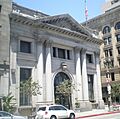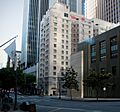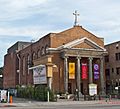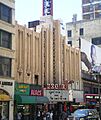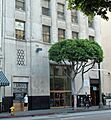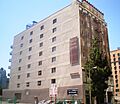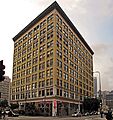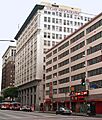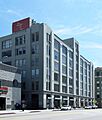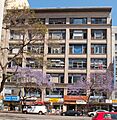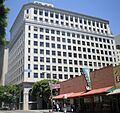List of Los Angeles Historic-Cultural Monuments in Downtown Los Angeles facts for kids
Los Angeles Historic-Cultural Monuments (LAHCMs) are special places in Downtown Los Angeles, Los Angeles, California. These are buildings, parks, and other spots that the city wants to protect because they are important to history and culture. There are over 120 of these amazing places in downtown LA!
Some of these special areas include the Old Plaza Historic District, Little Tokyo, Chinatown, the Broadway Theater District, the Spring Street Financial District, and the Fashion District. Let's explore some of the most interesting ones!
Contents
Cool Historic Buildings in Downtown LA
Downtown Los Angeles is full of old buildings with amazing stories. Many of these are LAHCMs, meaning they are officially recognized for their importance.
Famous Buildings You Can Visit
- Bradbury Building (HCM #6): This building, built in 1893, is famous for its incredible inside. It has a huge open space with lots of sunlight, fancy ironwork, and cool elevators. It's been in many movies!
- Los Angeles Central Library (HCM #46): Opened in 1926, this library looks like something from ancient Egypt! It's one of the biggest public libraries in the United States.
- Biltmore Hotel (HCM #60): This is a landmark hotel in downtown Los Angeles. It's a grand place with a lot of history.
- Los Angeles City Hall (HCM #150): Built in 1928, this is where the city government works. It's one of the tallest buildings in the world that's designed to withstand earthquakes. It mixes old-style architecture with a modern tower.
- Union Station (HCM #101): This big train station opened in 1939. It was designed in a Spanish-colonial style and is still a busy place for trains and buses today.
- Eastern Columbia Building (HCM #294): This tall, thirteen-story building from 1895 has a cool "Zig-Zag Moderne" style. It stands out with its strong vertical lines and many windows.
- Higgins Building (HCM #873): Built in 1909, this 10-story building has a beautiful Beaux-Arts style. It used to house the Los Angeles County Engineer Department.
Buildings with Unique Stories
- Nuestra Senora la Reina de Los Angeles (HCM #3): Also known as Plaza Church, this church was built way back in 1822. It's one of the oldest buildings in the city.
- Saint Vibiana's Cathedral (HCM #17): This church was first opened in 1876 and has been updated many times. It's an important religious building in the city.
- Fire Station No. 23 (HCM #37): This old firehouse from 1910 has a fancy inside. It was even used as a filming location in movies like "Ghostbusters"!
- Los Angeles Athletic Club (HCM #69): This building, designed in 1912, was famous for its 100-foot-long swimming pool on the sixth floor when it opened!
- Palm Court (Alexandria Hotel) (HCM #80): This dining room is 200 feet long and has an amazing stained-glass ceiling. It's a truly beautiful space.
- Cole's P.E. Buffet-Pacific Electric Building (HCM #104): This restaurant opened in 1903 inside the Pacific Electric terminal building. It's a historic spot for a meal.
- Cohn-Goldwater Building (HCM #119): This was the first modern, strong concrete factory in Los Angeles, built in 1909 for clothing makers.
- Coca-Cola Building (HCM #138): Built in 1939, this building looks like a ship with portholes and a bridge! It's a great example of "Streamline Moderne" style.
- Wolfer Printing Company Building (HCM #161): This building from 1929 looks like an English print shop from the 1800s.
- Subway Terminal Building (HCM #177): Built in 1925, this building used to be the main stop for the "Hollywood Subway." Now, it's a luxury apartment building.
- Los Angeles Herald Examiner Building (HCM #178): This building, completed in 1915, was designed by a famous architect, Julia Morgan. It has a Spanish Colonial Revival style.
- James Oviatt Building (HCM #195): This Art Deco building from 1928 is known for its beautiful Lalique glass.
- Los Angeles Stock Exchange Building (HCM #205): Opened in 1931, this building has cool bronze doors and ceiling murals inside.
- Farmers and Merchants Bank Building (HCM #271): Built in 1904, this was a very important bank in the early days of Los Angeles.
- Fire Station No. 30 (HCM #289): This fire station, built in 1942, was the city's first segregated firehouse for African-American firefighters. It remained segregated for 25 years.
- Japanese Union Church of Los Angeles (HCM #312): Built in 1923, this was the first church for a Protestant Japanese-American group in the city. It's now the Union Center for the Arts.
- Los Angeles Hompa Hongwanji Buddhist Temple (HCM #313): This Buddhist temple, built in 1924-25, was one of the first religious buildings for Asian people in the city. It later became the Japanese American National Museum.
- One Bunker Hill Building (HCM #347): This 14-story Art Deco building was built between 1930 and 1934. It used to be the Southern California Edison Company Building.
- Fire Station No. 28 (HCM #348): This former fire station from 1922 is now a restaurant that serves food based on old fire station recipes!
- Giannini-Bank of America (HCM #354): This building from 1922 has huge columns and fancy stone work. It was originally built for the Bank of Italy.
- Barker Brothers Building (HCM #356): Built in 1925, this was the main store for the city's biggest home furnishings company.
- Petroleum Building (HCM #596): Designed in 1925, this building looks like the old palaces of Florence, Italy.
- San Pedro Firm Building (HCM #615): This building from 1925 shows the history of the Japanese American community. It had apartments above stores.
- Gerry Building (HCM #708): This "Streamline Modern" building in the Fashion District was originally used to make clothes. Now, it's condominiums.
- Textile Center Building (HCM #712): This landmark building in the Fashion District was built in 1926 by a pioneering female developer, Florence Casler.
- San Fernando Building (HCM #728): This office building from 1906 is part of the "Old Bank District" and has a Renaissance Revival style.
- South Park Loft Building (HCM #748): This high-rise parking garage from 1924 is now known as "South Park Lofts."
- General Petroleum Building (HCM #766): Built in 1949 as offices for an oil company, this high-rise is now the Pegasus Apartments.
- Kerckoff Building and Annex (HCM #806): This building is a significant part of downtown's history.
- National Biscuit Company Building (HCM #888): This building was once home to the famous biscuit company.
- Hotel Cecil (HCM #1140): This Beaux-Arts style hotel was built in 1924.
- Grand Central Market (HCM #1183): This building from 1896 houses both offices and a popular public market.
- Union Bank Plaza (HCM #1206): This skyscraper, built in 1968, was the first LA skyscraper to be listed as a historic monument.
Historic Theaters
The Broadway Theater District has many old movie palaces.
- Los Angeles Theater (HCM #225): Designed by a famous theater architect, S. Charles Lee, this theater opened in 1931.
- Palace Theater (HCM #449): Built in 1911, this theater was one of the first to use colorful terra-cotta on its outside in Los Angeles.
- Tower Theatre (Los Angeles) (HCM #450): This theater, built in 1927, was the first in downtown to be built for "talking motion pictures" (movies with sound!).
- Mayan Theater (HCM #460): Built in 1927, this theater has cool Mayan decorations. It's now a night club.
- Belasco Theater (HCM #476): This six-story theater was built in 1926 for live shows.
- State Theater Building (HCM #522): This steel-reinforced theater was built in 1921.
- United Artists Theater Building (HCM #523): This was the first theater built by the famous movie company United Artists, in 1927. It has a Spanish Gothic style.
- Cameo Theater (HCM #524): Built in 1910, this was the longest continuously operating movie theater in California until it closed in 1991.
- Arcade Theater (HCM #525): This theater was built in 1910 by a vaudeville producer.
- Roxie Theater (HCM #526): This Art Deco movie theater was built in 1931.
- Million Dollar Theater (NRHP): This is one of the very first movie palaces ever built in the United States.
Unique Transportation and Public Spaces
- Angels Flight (HCM #4): This is a short funicular railway that takes people up and down a steep hill. It has operated for many years, carrying people between Hill Street and Bunker Hill.
- Plaza Park (HCM #64): This historic park is where the city of Los Angeles was first settled. It includes many of the city's oldest and most important buildings.
- River Station Area – Southern Pacific Railroad (HCM #82): This area, now Los Angeles State Historic Park, still has parts of the old 19th-century railroad, like freight yards and cobblestone streets.
- Granite Block Paving (HCM #211): Bruno Street has the last remaining original paving made of hand-cut granite blocks. It's a cool piece of history under your feet!
- Macy Street Viaduct (HCM #224): Built in 1926, this bridge has a Spanish Colonial Revival style with fancy columns and street lights with the City Seal.
- Spanish–American War Memorial (HCM #480): This life-size granite statue in Pershing Square was completed in 1900 to remember soldiers who died in the Spanish-American War.
- Chinatown West Gate (HCM #825) and Chinatown East Gate (HCM #826): These are the beautiful gates into New Chinatown, which was created in 1938 by Chinese-Americans. The East Gate leads into what was the first outdoor mall in the United States!
- Aoyama Tree (HCM #920): This large rubber tree, planted in the 1920s, is a symbol of the history of the Koyasan Buddhist Temple and Japanese Americans in Los Angeles.
Images for kids
See also
- Historic-Cultural Monuments on the East and Northeast Sides
- Historic-Cultural Monuments in the Harbor area
- Historic-Cultural Monuments in Hollywood
- Historic-Cultural Monuments in the San Fernando Valley
- Historic-Cultural Monuments in Silver Lake, Angelino Heights, and Echo Park
- Historic-Cultural Monuments in South Los Angeles
- Historic-Cultural Monuments on the Westside
- Historic-Cultural Monuments in the Wilshire and Westlake areas
- City of Los Angeles' Historic Preservation Overlay Zones
- National Register of Historic Places listings in Los Angeles
- National Register of Historic Places listings in Los Angeles County
- List of California Historical Landmarks

































